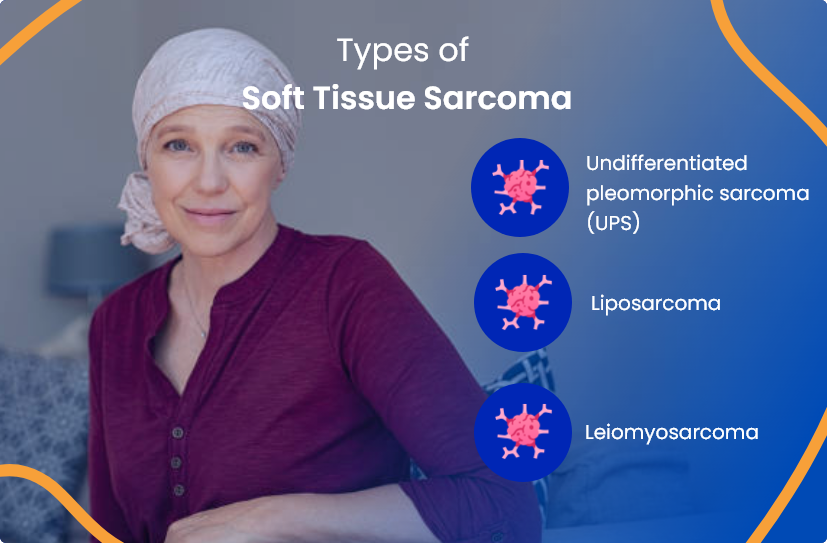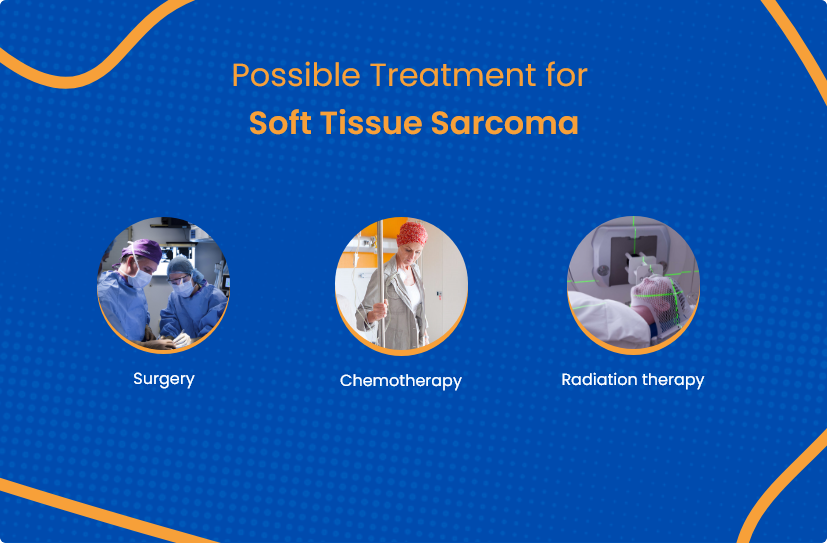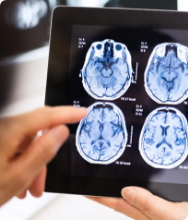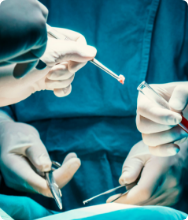
Book a Consultation
Thank you!
Your form has been sent successfully.

Cancers that develop in soft tissues (muscle, tendons, fat, lymph and blood vessels, and nerves) are called soft tissue sarcomas. Although they can appear anywhere on the body, these malignancies commonly occur in the arms, legs, chest, and abdomen. These rare cancers account for < 1% of all adult malignancies.
Soft tissue sarcomas are classified into more than 50 subtypes. Here are the three most common types:

UPS stands for undifferentiated pleomorphic sarcoma. The back of the abdomen, the arms, or the legs, particularly the thighs, are where it typically manifests. These tumors frequently develop quickly and can metastasize to other body parts.
A malignant tumor that develops in the body's fat tissue. In addition to the stomach, the condition can also affect the thighs and other areas.
Generally, this type of cancer develops in smooth muscle tissue (involuntary muscles) and can occur anywhere in the body. Leiomyosarcoma is commonly found in the stomach and uterus.
Consult a doctor straight away if you have any of these issues:
 A newly developed bulge or a developing lump (anywhere on the body)
A newly developed bulge or a developing lump (anywhere on the body)
 Intensifying abdominal pain
Intensifying abdominal pain
 Blood in vomit or feces
Blood in vomit or feces
 Trouble while breathing
Trouble while breathing
Soft tissue sarcoma cancer comes in various forms, so it's crucial to identify each tumor's precise nature to select the most effective treatment.

Surgery is the most common first step in treating the condition.
Surgery may be able to remove a sarcoma, depending on its location and size. Surgery aims to remove the entire tumor and at least 1 to 2 cm (less than an inch) of surrounding healthy tissue. This process is followed to ensure that no cancer cells are left behind. The doctor will check to see if cancer is developing in the specimen's margins when the surgically extracted tissue is examined under a microscope.
Doctors can also surgically remove any secondary cancers if the primary tumor has spread to other locations in the body.
Cancer patients are treated with chemotherapy by administering medications intravenously or orally. This treatment is effective for cancer that has spread (metastasized) to other organs since these medications reach all parts of the body through the bloodstream. Chemotherapy may be used as the primary treatment or as an adjuvant (supplement to) surgery, depending on the kind and stage of the sarcoma.
In radiation therapy, high-energy particle beams emit X-rays or gamma rays that destroy the DNA of cancerous cells. Although some normal cells will also be destroyed from this exposure, rapidly dividing cells, such as tumor cells, are considerably more likely to perish from it. To maximize the efficiency of both methods and eliminate more tumor cells, physicians will occasionally mix chemotherapy and radiation therapy.
Doctors may use the following diagnostic methods to assess the region of concern.


In order to ensure effective surgical treatment and planning, doctors may select from amongst the following biopsy procedures.
Tumor material can be extracted in tiny tubes using this technique. Typically, medical professionals collect samples from multiple areas of the tumor.
Doctors may recommend surgery to remove a small tumor completely or to obtain a larger sample of tissue.
Our patients have access to a multispecialty team of professionals at ACTC, who work together in a highly collaborative and coordinated manner to provide all aspects of cancer care in one convenient location in Brooksville, Florida. Our doctors are supported by a clinical team with over two decades of experience and a reputation for providing tailored and supportive cancer care.
The following are our providers who you can consult at ACTC:

MD, Hematology & Oncology

MD, Ph.D., Hematology/ Medical Oncology

MD, Radiation Oncologist

Cancer patients look for a sense of trust and care once diagnosed. At ACTC, we make it our priority to make them feel secure and optimistic about the journey ahead. Our state of the art mechanisms and dedicated team of specialists are there at all times for support. From staging to treatment to long-term follow-up, we make sure no hurdle is faced by our patients.
Schedule a consultation by calling
 352-345-4565
352-345-4565
They often spread to other parts of the body, particularly the lungs, and typically grow rapidly. In the affected location, they frequently induce pain or swelling.
Yes. Cancerous (malignant) tumors called soft tissue sarcomas develop in the body's soft tissues.
The majority of soft tissue sarcomas develop in the arms, legs, abdomen, and retroperitoneum of the body.
Schedule a consultation by calling
 352-345-4565
352-345-4565